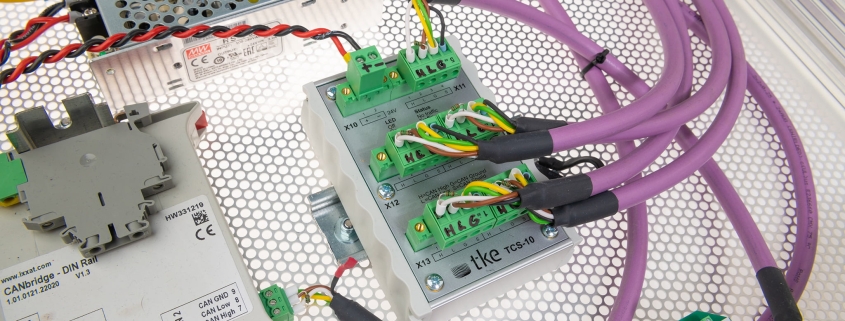How to Maximize Efficiency Using the TCS-10
The TCS-10 CAN switch bridge offers powerful capabilities for optimizing industrial network performance. To maximize efficiency with this device, focus on proper configuration, strategic placement within your network architecture, and regular monitoring of diagnostic data. The TCS-10 excels at managing network traffic, reducing bus load, and enabling segmentation of CAN networks—all critical factors for maintaining stable, high-performance industrial communication systems. With the right implementation approach, the TCS-10 can significantly enhance overall network reliability while simplifying maintenance procedures.
Understanding the TCS-10 and its role in industrial networking
The TCS-10 is a specialized CAN switch bridge designed to optimize communication in industrial networking environments. It serves as a critical infrastructure component that intelligently manages CAN-bus traffic, allowing for network segmentation and improved data flow management.
At its core, the TCS-10 works by creating logical segments within CAN networks, preventing unnecessary message flooding and allowing for more targeted communication between devices. This capability is particularly valuable in complex industrial settings where multiple systems must communicate efficiently without overwhelming the network.
The significance of the TCS-10 becomes apparent when considering the challenges of modern industrial networking. As manufacturing and automation systems grow increasingly sophisticated, the demand for reliable, low-latency communication becomes paramount. Traditional CAN networks face limitations when scaled beyond certain thresholds, including:
- Bus load constraints that reduce overall system performance
- Difficulties isolating network segments for maintenance or troubleshooting
- Increased vulnerability to network-wide failures from localized issues
- Challenges in managing message priorities across large systems
By implementing the TCS-10, system architects can overcome these limitations, creating more resilient and efficient industrial networks. The device’s ability to filter and route messages intelligently ensures that only relevant data traverses network segments, significantly reducing overall bus load and improving system responsiveness.
What are the key features of the TCS-10 that enhance network efficiency?
The TCS-10 incorporates several technical features specifically designed to boost network performance and reliability. Its sophisticated message filtering capabilities stand at the forefront of these efficiency-enhancing features, allowing precise control over which messages pass between network segments.
The primary efficiency-boosting features include:
- Intelligent switching: The TCS-10 examines message identifiers and selectively forwards only relevant messages between segments, preventing unnecessary network traffic and reducing overall bus load.
- Bridge functionality: Creates logical connections between physically separate CAN networks, enabling seamless communication while maintaining segment isolation when beneficial.
- Diagnostic capabilities: Built-in monitoring tools provide real-time insights into network health, traffic patterns, and potential bottlenecks.
- Error containment: Prevents error propagation across network boundaries, isolating faults to specific segments rather than affecting the entire system.
- Message prioritization: Ensures critical communications receive appropriate priority, maintaining responsiveness for time-sensitive operations.
These capabilities collectively transform how CAN-bus networks operate in industrial environments. By intelligently managing traffic flow, the TCS-10 effectively increases available bandwidth on each network segment. This results in faster response times for critical operations and reduces the likelihood of communication delays or failures.
For applications requiring deterministic performance, the TCS-10’s ability to segregate traffic proves invaluable. Time-sensitive control operations can be isolated from lower-priority monitoring functions, ensuring consistent system performance even as network complexity increases.
| Feature | Efficiency Benefit |
|---|---|
| Message Filtering | Reduces bus load by up to 70% through selective message forwarding |
| Network Segmentation | Isolates traffic patterns, preventing congestion across segments |
| Error Containment | Limits fault propagation, improving overall system uptime |
| Diagnostic Tools | Enables proactive identification of network issues before they impact performance |
How do you properly configure the TCS-10 for optimal performance?
Configuring the TCS-10 correctly is essential for achieving maximum network efficiency. The initial setup requires careful planning and consideration of your specific network topology and communication requirements.
Start by identifying the logical network segments in your system. These should be grouped based on communication patterns, with devices that frequently exchange data placed within the same segment when possible. This preliminary analysis will inform your filtering configuration decisions.
Follow these configuration steps for optimal performance:
- Connect to the TCS-10 using the configuration interface and verify physical connections are secure.
- Set appropriate CAN bus speeds for each port, ensuring they match the connected devices.
- Configure message filtering rules based on your network analysis, specifying which message IDs should pass between segments.
- Implement priority settings for time-critical messages to ensure they receive preferential treatment.
- Enable diagnostic logging at an appropriate level to monitor performance without creating excessive overhead.
- Test the configuration with representative traffic patterns before full deployment.
The most critical aspect of configuration is the message filtering strategy. Overly permissive filtering reduces efficiency gains, while excessively restrictive settings might block necessary communications. Aim for a balanced approach where only genuinely needed messages traverse segment boundaries.
Regular review and refinement of your configuration settings will ensure continued optimal performance as your network evolves. Monitor traffic patterns and adjust filtering rules accordingly to maintain efficiency as communication requirements change.
What common issues can reduce TCS-10 efficiency and how can you resolve them?
Several operational challenges can diminish the TCS-10’s effectiveness if not properly addressed. Identifying and resolving these issues promptly is crucial for maintaining optimal network performance.
The most frequent efficiency-reducing issues include:
- Improper message filtering: Either too permissive (allowing unnecessary traffic between segments) or too restrictive (blocking required communications). Solution: Regularly audit and refine filter rules based on actual traffic patterns and communication requirements.
- Physical connection problems: Loose connections, cable degradation, or electromagnetic interference can cause intermittent errors. Solution: Implement proper cable shielding, secure physical connections, and periodically inspect cabling infrastructure.
- Configuration mismatches: Different baud rate settings between the TCS-10 and connected devices lead to communication failures. Solution: Verify consistent speed settings across all network devices and document configurations thoroughly.
- Excessive bus load: Even with proper segmentation, individual network segments can become overloaded. Solution: Monitor bus utilization and consider further segmentation or message optimization if utilization consistently exceeds 60%.
- Firmware issues: Outdated firmware may lack important optimizations or fixes. Solution: Maintain current firmware versions and review release notes for relevant improvements.
Diagnostic data provides valuable insights when troubleshooting efficiency problems. The TCS-10 includes monitoring capabilities that can help identify patterns such as recurring error frames, bandwidth bottlenecks, or message collisions. Regular analysis of this data enables proactive optimization before issues impact operations.
Implementing a systematic maintenance schedule that includes verification of configuration settings, physical connections, and performance metrics will help prevent efficiency degradation over time. Document any changes to network topology or communication requirements to inform ongoing configuration adjustments.
How can the TCS-10 be integrated with existing CAN-bus systems?
Integrating the TCS-10 into established network infrastructures requires careful planning to minimize disruption while maximizing benefits. The device is designed for seamless incorporation into existing CAN-bus systems, but several considerations will ensure successful implementation.
For smooth integration, follow these strategic approaches:
- Begin with comprehensive network mapping, documenting all existing devices, communication patterns, and critical message IDs.
- Identify natural segmentation points where network traffic naturally clusters, such as functional areas or machine boundaries.
- Plan a phased implementation that allows for testing and validation before complete deployment.
- Create a temporary parallel configuration where the TCS-10 operates alongside existing communication paths before fully transitioning.
- Develop and test message filtering rules in isolation before applying them to production systems.
Compatibility considerations are essential during integration. The TCS-10 supports standard CAN protocols but verify that any proprietary message formats or application-layer protocols used in your system will function correctly across the switch bridge.
One effective integration strategy involves initially configuring the TCS-10 with minimal filtering, allowing all messages to pass between segments. This establishes a baseline for normal operation before gradually implementing more selective filtering rules based on observed traffic patterns. This approach minimizes the risk of inadvertently blocking critical communications.
For systems with particularly stringent uptime requirements, consider implementing the TCS-10 during scheduled maintenance windows, with a clear rollback plan should unexpected issues arise. Always maintain detailed documentation of the original network configuration to facilitate troubleshooting during the transition period.
Key takeaways for maximizing your TCS-10 efficiency
To achieve and maintain peak performance with your TCS-10, focus on these essential optimization strategies and best practices. Implementing these recommendations will help ensure your industrial network operates at maximum efficiency.
The most impactful approaches for long-term TCS-10 optimization include:
- Develop and maintain detailed documentation of your network topology, message patterns, and TCS-10 configuration settings.
- Implement regular performance monitoring routines that track key metrics like bus load, error rates, and message latencies.
- Periodically review and refine message filtering rules as system requirements evolve.
- Keep firmware updated to benefit from the latest optimizations and feature enhancements.
- Train technical staff on CAN-bus principles and TCS-10 configuration to build in-house expertise.
Proper maintenance routines significantly contribute to sustained efficiency. Schedule regular checkups that include physical inspection of connections, verification of configuration settings, and analysis of diagnostic data. These preventative measures help identify potential issues before they impact system performance.
Remember that network requirements evolve over time. As you add new devices or modify communication patterns, revisit your TCS-10 configuration to ensure it remains optimally tuned for current conditions. What worked perfectly for your initial implementation may require adjustments as your system grows.
By following these guidelines and leveraging the TCS-10’s capabilities effectively, you can create more resilient, efficient industrial networks that provide reliable communication even as systems scale in complexity. For specific guidance tailored to your unique network requirements, our team is available to provide personalized support and additional fieldbus solutions.
Interested in real-world automation solutions?
Browse our case studies to discover how we support safe and efficient operations through smart control and networking systems

 MARIN
MARIN
